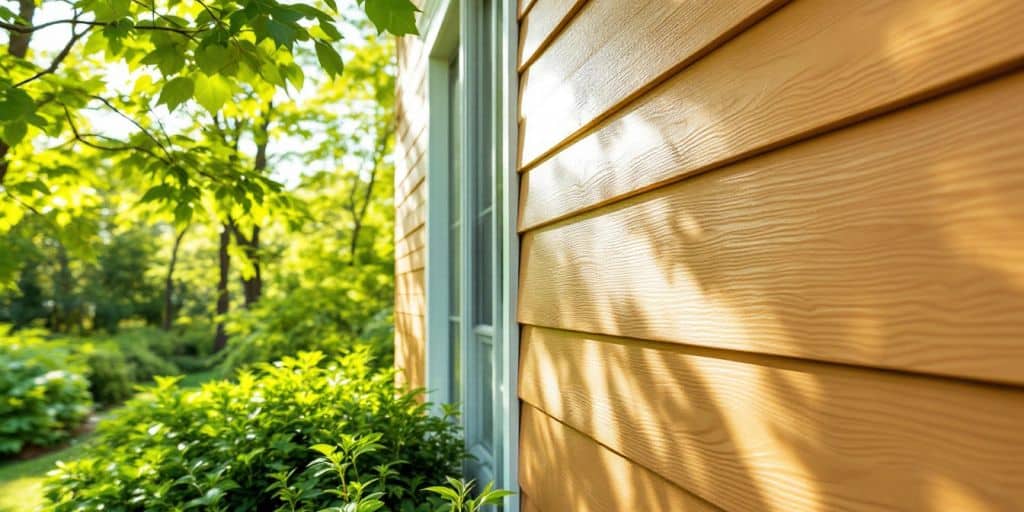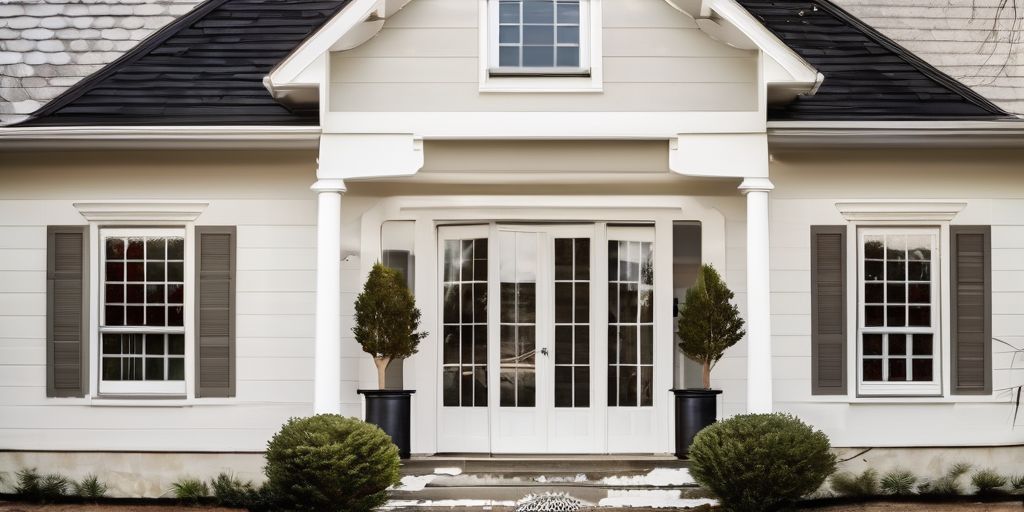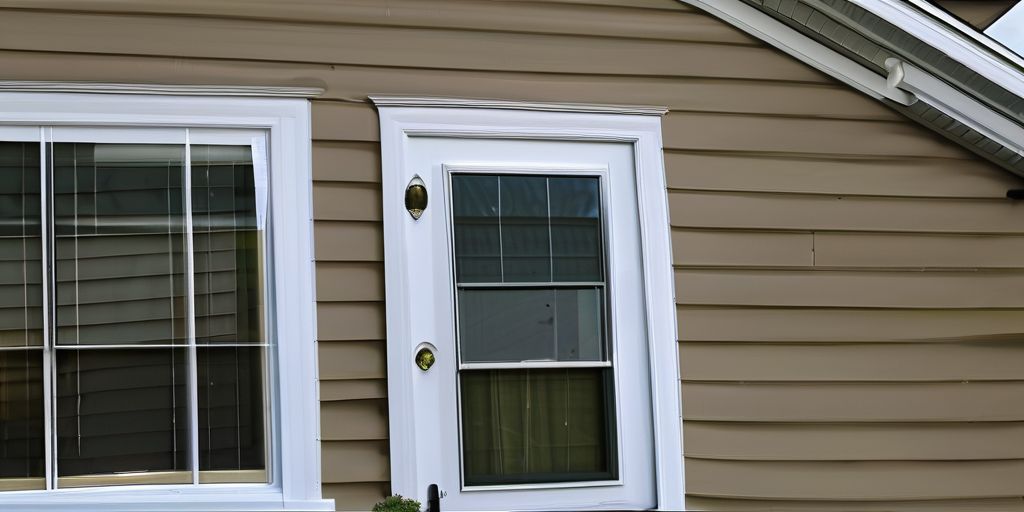Painting vinyl siding in Hamilton requires a good understanding of the local weather. The climate can change quickly, affecting how paint sticks and dries. By knowing what to expect, you can choose the best time and materials for your project.
Key Takeaways
- Know the seasonal changes in Hamilton to plan your painting job well.
- Pick paint that can handle tough weather for lasting results.
- Make sure to clean and fix the siding before you start painting.
- Use even techniques when applying paint for a smooth finish.
- Give the paint enough time to dry and set for the best results.
Understanding Hamilton’s Climate for Vinyl Siding Painting
Hamilton’s climate plays a significant role in how and when to paint vinyl siding. Understanding seasonal changes is essential for achieving a long-lasting finish. Here’s a breakdown of the key factors:
Seasonal Changes and Their Impact
- Spring: Rapid temperature changes can affect how well the paint sticks.
- Summer: High humidity can slow down drying times, making it tricky to get a smooth finish.
- Fall: Cooler temperatures and possible frost can hinder paint application and curing.
- Winter: Generally, it’s not a good idea to paint due to low temperatures and snow.
When planning your painting project, aim for a stretch of days with consistent weather patterns to ensure the best results.
Weather Patterns to Consider
Hamilton experiences unique weather patterns that can impact your painting project:
- Spring and Fall: Moderate temperatures are ideal for painting.
- Summer: Hot and humid conditions may affect how quickly the paint dries.
- Winter: Cold and snowy weather can pose challenges for outdoor work.
Temperature Fluctuations and Vinyl Siding
Temperature changes can cause vinyl siding to expand and contract, which may lead to issues like cracking or peeling paint. Here are some important points to keep in mind:
- Expansion and Contraction: Vinyl siding reacts to heat and cold, especially during Hamilton’s variable spring and fall seasons.
- Moisture Resistance: While vinyl is generally moisture-resistant, prolonged wet conditions can lead to mold and mildew.
- UV Exposure: The strong summer sun can fade colors, making UV-resistant paint a necessity.
By being aware of Hamilton’s climate, homeowners can ensure that their vinyl siding is painted under the most favorable conditions, leading to a long-lasting and aesthetically pleasing finish. Remember, the right timing and preparation are key to a successful painting project!
Choosing the Right Paint for Hamilton’s Climate
When it comes to painting vinyl siding in Hamilton, selecting the right paint is crucial for ensuring durability and longevity. Hamilton’s unique climate presents specific challenges that homeowners must consider.
Durability and Weather Resistance
- Weather resistance: Choose paints that can withstand Hamilton’s harsh winters and humid summers.
- UV protection: Look for paints that offer protection against fading from the sun.
- Flexibility: Opt for paints that remain flexible when dry to accommodate the expansion and contraction of vinyl siding due to temperature changes.
UV Protection and Color Fading
- Light colors: These tend to reflect sunlight, reducing heat absorption during hot summers.
- Dark colors: While they absorb more heat, select paints with a high Light Reflectance Value (LRV) of 57 or higher to minimize heat retention.
- Environmental harmony: Consider colors that blend with Hamilton’s natural surroundings, especially near landmarks like the Royal Botanical Gardens.
Environmental Considerations
- Low VOCs: Choose paints with low or zero volatile organic compounds to reduce air pollution.
- Long-lasting products: Opt for paints that require less frequent repainting to minimize environmental impact.
- Renewable energy: Support manufacturers that use renewable energy sources in their production processes.
Remember, the right paint not only enhances the appearance of your home but also contributes to its energy efficiency and longevity. Regular maintenance and proper application techniques are essential for achieving the best results.
Preparing Vinyl Siding for Painting
Before you start painting your vinyl siding, it’s essential to ensure that the surface is clean and ready. Proper preparation is key to achieving a long-lasting and attractive finish. Here’s how to prepare your siding:
Cleaning and Surface Preparation
- Wash the siding: Use a mixture of soapy water and a soft brush to remove dirt, grime, and mildew.
- Rinse thoroughly: Make sure to rinse off all soap residue with clean water.
- Inspect for damage: Look for cracks, holes, or warping that could affect the paint job.
- Repair any damage: Fix any issues you find, such as patching holes or replacing damaged sections.
- Dry completely: Allow the siding to dry fully, especially in Hamilton’s humid climate, to prevent peeling paint.
Remember, taking your time during the cleaning and preparation process is crucial. Rushing can lead to a less-than-perfect finish.
Repairing Damaged Siding
- Check for wear: Look for signs of damage like cracks or warping.
- Fill minor cracks: Clean the area and use caulk that’s compatible with vinyl.
- Replace larger sections: If needed, carefully remove and replace damaged pieces.
Priming for Better Adhesion
- Choose the right primer: Make sure it’s suitable for vinyl and the local climate.
- Apply evenly: Use a thin coat of primer and let it dry completely before painting.
- Protect against elements: Priming helps shield the siding from Hamilton’s unpredictable weather.
By following these steps, you can ensure that your vinyl siding is well-prepared for painting, leading to a beautiful and durable finish. If you find yourself waiting for the siding to dry, consider a stroll through Hamilton’s scenic Royal Botanical Gardens to enjoy the beauty of nature while you work!
Techniques for Applying Paint to Vinyl Siding
Tools and Materials Needed
To achieve a smooth and even finish when painting vinyl siding, having the right tools is essential. Here’s a list of what you’ll need:
- High-quality paintbrushes or rollers designed for exterior use.
- A paint sprayer for larger areas, ensuring uniform coverage.
- Drop cloths to protect surrounding areas from paint splatters.
- Ladders or scaffolding for reaching higher sections safely.
Steps for Even Coverage
Applying paint evenly is crucial for a professional look. Follow these steps:
- Clean the siding thoroughly to remove dirt and mildew.
- Apply paint in thin layers to avoid drips and ensure even coverage.
- Maintain a wet edge by working in sections and overlapping wet paint.
Remember, patience is key. Rushing can lead to uneven coverage and a less durable finish.
Avoiding Common Mistakes
To ensure a long-lasting paint job, keep these common mistakes in mind:
- Avoid painting in extreme temperatures or during rain.
- Ensure humidity levels are within the recommended range for the paint.
- Don’t paint in direct sunlight, as it can cause the paint to dry too quickly.
In Hamilton, where the Royal Botanical Gardens provide a beautiful backdrop, taking your time with these techniques will reflect in the quality of your work. By following these guidelines, you can achieve a finish that not only looks great but also withstands the local weather conditions.
Maintaining Painted Vinyl Siding in Hamilton
Regular Maintenance Tips
To keep your painted vinyl siding looking great and lasting longer, consider these maintenance tips:
- Inspect regularly for any signs of wear or damage.
- Clean the siding at least once a year to remove dirt and grime.
- Check for mold or mildew, especially in shaded areas.
Addressing Mold and Mildew
Mold and mildew can be a problem in Hamilton’s humid climate. Here’s how to tackle it:
- Use a mixture of water and mild detergent to scrub affected areas.
- Rinse thoroughly with water to remove any residue.
- For stubborn spots, consider using a solution specifically designed for mold removal.
Handling Peeling and Cracking
If you notice peeling or cracking paint, it’s important to address it quickly:
- Remove any loose paint with a scraper.
- Sand the area to create a smooth surface.
- Repaint with a suitable exterior paint to ensure a uniform look.
Regular upkeep is key to preserving the beauty and integrity of your vinyl siding. By staying proactive, you can avoid larger issues down the road.
In Hamilton, where the weather can be unpredictable, maintaining your vinyl siding is essential. Remember, a little effort goes a long way in keeping your home looking its best, especially near landmarks like the Royal Botanical Gardens.
Timing Your Painting Project
Best Seasons for Painting
When planning to paint your vinyl siding in Hamilton, consider the following seasons:
- Spring: Ideal for painting as temperatures start to warm up, but be cautious of sudden rain.
- Summer: While warm, high humidity can slow down drying times, so choose days with lower humidity.
- Fall: Cooler temperatures are great for painting, but watch for frost, especially in late fall.
- Winter: Generally not recommended due to low temperatures and snow.
Monitoring Weather Conditions
To ensure a successful painting project, keep an eye on the weather. Here are some tips:
- Check forecasts regularly for temperature and humidity levels.
- Avoid painting during extreme weather conditions, such as heavy rain or high winds.
- Plan for drying time; allow sufficient time between coats for the paint to dry properly.
Scheduling for Optimal Results
For the best results, consider these scheduling tips:
- Choose a stretch of days with consistent weather patterns.
- Start early in the day to take advantage of cooler temperatures.
- Be flexible; if the weather changes, be ready to adjust your schedule.
Remember, patience is key. Rushing the process can lead to unsatisfactory results and the need for premature repainting.
In Hamilton, where landmarks like the Royal Botanical Gardens showcase nature’s beauty, your home’s exterior should reflect that same care and attention. By timing your painting project wisely, you can achieve a finish that lasts and looks great!
Color Selection Tips for Hamilton Homes
When it comes to choosing the right color for your vinyl siding in Hamilton, it’s important to think about how the local climate can affect your choice. Here are some key points to consider:
Choosing Climate-Suitable Colors
- Lighter colors reflect sunlight, helping to keep your home cooler during hot summers.
- Darker colors absorb heat, which can lead to higher cooling costs. If you prefer a darker shade, look for paints with a high Light Reflectance Value (LRV) of 57 or higher.
- Consider the natural surroundings; for example, if you live near the Royal Botanical Gardens, earthy tones can blend beautifully with the landscape.
Balancing Aesthetics and Functionality
- Choose colors that not only look good but also resist fading from the sun.
- Think about how the color will complement your home’s architectural style. For instance, traditional homes may look best in classic colors, while modern designs can handle bolder choices.
- High-quality paint is essential for durability and weather resistance, ensuring your color stays vibrant longer.
Popular Color Choices in Hamilton
- Neutral tones are always a safe bet, providing a timeless look.
- Bold accents can add character; consider using them on doors or shutters.
- Pastel shades can create a soft, inviting appearance, especially in residential areas.
Remember, the right color not only enhances your home’s beauty but also contributes to its energy efficiency. Regular maintenance will help keep your chosen color looking fresh and vibrant for years to come.
Choosing the right colors for your Hamilton home can make a big difference in its look and feel. Think about the style of your house and the vibe you want to create. Light colors can make a space feel bigger, while darker shades can add warmth and coziness. Don’t forget to check out our website for more tips and to get a free estimate on our painting services!
Conclusion
In summary, painting vinyl siding in Hamilton’s climate requires careful thought about the weather and the right techniques. By using the tips shared in this article, homeowners can achieve a beautiful and lasting finish for their vinyl siding. Always remember to clean the surface, pick the right paint, and apply it properly for the best outcome. With these guidelines, you can confidently take on your vinyl siding painting project and boost your home’s curb appeal.
Frequently Asked Questions
Do I need to paint my vinyl siding in Hamilton’s weather?
Yes, painting your vinyl siding can protect it from harsh weather and help it last longer.
What type of paint should I use for vinyl siding in Hamilton?
Acrylic latex paint is a good choice because it’s strong and can handle the weather well.
How often should I repaint my vinyl siding in Hamilton?
It depends on the paint quality and how much weather exposure your siding gets.
Is it better to paint vinyl siding myself or hire a pro in Hamilton?
You can do it yourself, but hiring a professional can save time and ensure a nice finish.
What mistakes should I avoid when painting vinyl siding in Hamilton?
Avoid painting in bad weather, using the wrong paint, and skipping surface cleaning.
How long does it take for the paint to dry on vinyl siding in Hamilton?
It usually takes a few days for the paint to dry and set, depending on the weather.




